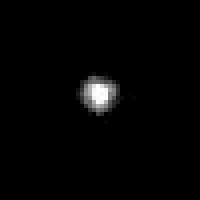20000 Varuna
20000 Varuna is a big Kuiper belt object (KBO). It could be a dwarf planet. Before it was named Varuna, it had the provisional designation 2000 WR106.
 Hubble Space Telescope image of Varuna | |
| Discovery | |
|---|---|
| Discovered by | R. McMillan (Spacewatch) |
| Discovery date | 28 November 2000 |
| Designations | |
| MPC designation | 20000 Varuna |
| 2000 WR106 | |
| TNO (cubewano)[1] | |
| Orbital characteristics | |
| Epoch 14 July 2004 (JD 2453200.5) | |
| Aphelion | 6 781.985 Gm (45.335 AU) |
| Perihelion | 6 120.810 Gm (40.915 AU) |
| 6 451.398 Gm (43.129 AU) | |
| Eccentricity | 0.051 |
| 103 440.6 d (283.20 a) | |
Average orbital speed | 4.53 km/s |
| 89.673° | |
| Inclination | 17.2° |
| 97.296° | |
| 271.631° | |
| Physical characteristics | |
| Dimensions | 800 km (avg of thermals)[2] (scalene ellipsoid)?[3][4] |
| Mass | ≈3.7×1020? kg[3][5] |
Mean density | 0.992 g/cm³[3] |
| 0.15 m/s² | |
| 0.39 km/s | |
Sidereal rotation period | 0.132 16 d (3.17 h) |
| Albedo | 0.037–0.26[2] |
| Temperature | ≈43–41 K |
Spectral type | (moderately red) B-V=0.93 V-R=0.64[6] |
| 19.9 (opposition)[7] | |
| 3.7[8] | |
Varuna is named after the Hindu deity Varuṇa.
Physical characteristics
Varuna completes one rotation in about 3.17 hours (or 6.34 hours, depending on whether the light curve is single or double-peaked). Given the fast rotation, which is not common for objects so big, Varuna is thought to be a stretched spheroid, with a density around 1g/cm³ (close to the density of water).[4]
The surface of Varuna is somewhat red and small amounts of water ice have been found on its surface.[9]
20000 Varuna Media
Varuna was discovered with the Spacewatch 0.9-meter telescope at the Kitt Peak National Observatory
References
- ↑ Marc W. Buie (2007-01-12). "Orbit Fit and Astrometric record for 20000". SwRI (Space Science Department). Retrieved 2008-09-19.
- ↑ 2.0 2.1 Stansberry (2008). "TNO/Centaur diameters and albedos". Retrieved 2006-11-08.
- ↑ 3.0 3.1 3.2 Lightcurves Lacerda P., Jewitt D. Dentisities Of Solar System Objects From Their Rotational Lightcurves", accepted to AJ Dec. 2006 Preprint
- ↑ 4.0 4.1 Jewitt D, Sheppard S (2002). "Physical Properties Of Trans-Neptunian Object (20000) Varuna". Astronomical Journal. 123 (April): 2110–2120. doi:10.1086/339557. S2CID 16543165. Preprint on arXiv.
- ↑ Calculated using Lacerda and Jewitt (2007) diameter of 900 km and density of 0.992 g/cm³.
- ↑ "TNO and Centaur Colors". Archived from the original on 2006-09-08. Retrieved 2006-11-08.
- ↑ "HORIZONS Web-Interface". JPL Solar System Dynamics. Retrieved 2008-07-02.
- ↑ "JPL Small-Body Database Browser: 20000 Varuna (2000 WR106)". 2007-11-17. Retrieved 2008-07-02.
- ↑ Licandro J, Oliva E, Di Martino M (2001). "NICS-TNG infrared spectroscopy of trans-neptunian objects 2000 EB173 and 2000 WR106". Astronomy & Astrophysics. 373 (July): 29–32L. doi:10.1051/0004-6361:20010758. S2CID 15690206.
{{cite journal}}: CS1 maint: multiple names: authors list (link)
Other websites
- "Size and Albedo of Kuiper Belt Object (20000) Varuna". David Jewitt's Home Page. Retrieved 2005-08-15. Site updated Reretrived on 2006-07-10
- Orbital simulation from JPL (Java) / Ephemeris